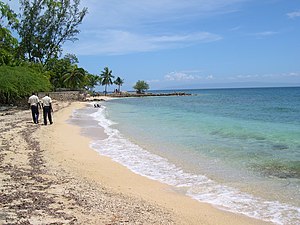Ouest (department)
Ouest
Lwès | |
|---|---|
 | |
 Ouest in Haiti | |
| Country | |
| Capital | Port-au-Prince |
| Government | |
| • Type | Departmental Council |
| Area | |
| • Department | 4,982.56 km2 (1,923.78 sq mi) |
| Population (2015)[1] | |
| • Department | 4,029,705 |
| • Density | 810/km2 (2,100/sq mi) |
| • Urban | 3,397,404 |
| • Rural | 632,301 |
| Time zone | UTC-5 (Eastern) |
| ISO 3166 code | HT-OU |
| HDI (2017) | 0.535[2] low · 1st |
Ouest (English: West, Haitian Creole: Lwès) is one of the ten departments of Haiti. It is the jurisdictional seat of the national capital, the city of Port-au-Prince. It has an area of 4,982.56 square kilometres (1,923.78 sq mi) and a population of 4,029,705 (2015 Estimate). It borders the Dominican Republic to the east.
It is the second largest department in Haiti after Artibonite. Gonâve Island is also part of the Ouest department. The department's stretch of coastline lies entirely in the Gulf of Gonâve.
Administrative divisions[]
The Department of Ouest is subdivided into five arrondissements, which are further subdivided into twenty communes.

(with 2009 Population Estimates in parentheses)[3]
- Arcahaie Arrondissement (180,564)
- Arcahaie (118,501)
- Cabaret (62,063)
- Croix-des-Bouquets Arrondissement (431,789)
- Cornillon (54,254)
- Croix-des-Bouquets (227,012)
- Fonds-Verettes (45,491)
- Ganthier (56,869)
- Thomazeau (48,163)
- La Gonâve Arrondissement (79,188)
- Anse-à-Galets (56,890)
- Pointe-à-Raquette (22,298)
- Léogâne Arrondissement (463,140)
- Grand-Goâve (124,135)
- Léogâne (181,709)
- Petit-Goâve (157,296)
- Port-au-Prince Arrondissement (2,509,939)
- Carrefour (465,019)
- Cité Soleil (241,055)
- Delmas (359,451)
- Gressier (33,152)
- Kenscoff (52,232)
- Pétion-Ville (342,694)
- Tabarre (118,477)
- Port-au-Prince (897,859)
- × — The communes of Cité Soleil and Tabarre are newly constituted, and did not exist at the time of the 2003 Census
History[]
Around 1772, Romaine-la-Prophétesse acquired a plantation named Trou Coffy in the department (likely in what is now ), becoming a prominent coffee grower and trader.[4] In 1791 and 1792, during the early Haitian Revolution, Romaine led some thirteen thousand slaves and rebels in freeing slaves from and burning the provinces plantations and briefly controlling two major cities, Léogâne and Jacmel.[5][6][7][8]
2010 7.0 earthquake[]

On 12 January 2010, a magnitude 7.0 earthquake struck in the department, the largest in Haiti in two centuries.[9] In the Port-au-Prince Arrondissement, many areas suffered damage.[10] In the Léogâne Arrondissement, the city of Léogâne suffered 80-90% destruction.[11] Other places[which?] in Léogâne were also affected.
Economy[]
Absolute poverty levels in the Ouest department are the lowest in the country.[12]
References[]
- ^ "Population Totale, De 18 ANS ET Plus" (PDF). Ministere De Le E'Conomie Et Des Finances (MEF). Retrieved 19 August 2018.
- ^ "Sub-national HDI - Area Database - Global Data Lab". hdi.globaldatalab.org. Retrieved 2018-09-13.
- ^ "IHSI" (PDF). Institut Haïtien de Statistique et d'Informatique. Retrieved 2 September 2014.
- ^ Rey 2017, pp. 28, 47, 49
- ^ Terry Rey (2017). The Priest and the Prophetess: Abbé Ouvière, Romaine Rivière, and the Revolutionary Atlantic World. pp. 28, 32–35, 48–49, 52.
- ^ Matthias Middell; Megan Maruschke (2019). The French Revolution as a Moment of Respatialization. p. 71.
- ^ James Alexander Dun (2016). Dangerous Neighbors: Making the Haitian Revolution. p. 65.
- ^ David F. Marley (2008). Wars of the Americas: A Chronology of Armed Conflict. p. 534.
- ^ CNN News Morning. 13 January 2010. Missing or empty
|title=(help) - ^ "The Situation Room". CNN. 15 January 2010.
- ^ Lisa Millar (17 January 2010). "Haiti Disaster Like "No Other"". ABC News. AFP. Retrieved 17 January 2010.
- ^ "Mapping Inequality in the Caribbean". December 4, 2010.
- Ouest (department)
- Departments of Haiti
- Haiti geography stubs
